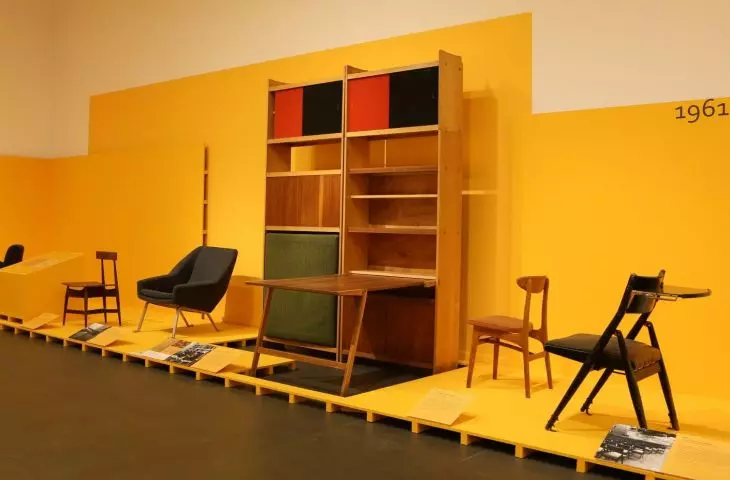Every year, universities across the country throw away interior furnishings from the communist era. During renovations, sometimes exceptionally good quality furniture and furnishings disappear, including specimens of the now prized mid-century modern trend from the 1950s and 1960s. A campaign to rescue them has been launched in Poznan. At the same time, the post-war achievements of Poznan designers can be seen at two exhibitions.
Cabinets, rooms, lecture halls and corridors in post-war buildings of Polish universities often owed their character to properly selected durable furniture. Not infrequently, in modernist buildings they were an integral part of the interior design, harmonizing with the door carpentry, partition walls or built-in closets in recesses. Today, after numerous alterations, modernizations and a period of aversion to equipment from the "middle communist" era, the amount of original equipment has significantly decreased. Fortunately, not so much so that it is difficult to assemble quite a successful collection of equipment from the now highly valued 1960s and - somewhat less popular - 1970s.
to the rescue
Hence the idea for the "Let's Save Design" campaign, which was initiated and led for more than a year by Prof. Piotr Korduba, director of the Art History Institute of the Faculty of Art Sciences at the Adam Mickiewicz University. The idea was simple: to look through the university's premises in search of old furniture, renovate it, research its origin and identify its authors and - continue to use it. Because, as the initiator of the campaign stresses, equipment from 50 or 40 years ago is not only functional, but also very durable. Not much is needed to restore them to their glory. Most often it is enough to repair minor damage and replace upholstery, which often gives the furniture a new shine and emphasizes its aesthetic qualities. Reuse is also a good contribution to thinking and acting with "zero waste" categories.
Period furniture, from chairs, to armchairs, to desks and closets, was found quite a lot, because, as Prof. Korduba often says:"poverty is the best conservator."
For many years the university could not afford to replace the equipment. Only in recent years have purchases of new ones moved more nimbly. However, these, in the opinion of art historians headed by the professor, cannot compare in terms of durability with the solid wood of years ago. The aesthetic aspect is also important, although, as Prof. Korduba notes, universities were not furnished with furniture of spectacular forms. Most are decent, durable equipment, with dimensions that optimally fit into the spaces of modernist buildings, proven at the stage of implementation and large-scale production.
just not a container!
The aspect of prototyping, manufacturing, and subsequent delivery of specific models to offices or universities is, by the way, something art historians from Poznan want to look into more closely - as part of a research grant from the National Science Center. Piotr Korduba, meanwhile, is encouraging colleagues from other UAM departments to take stock of their buildings. As it seems, related activities should also take place at other universities in Poznań and the country. Far too often, old equipment ends up in containers during renovations and goes to the landfill, although - after being crossed off the inventory - it could at least be "adopted" by amateurs of design from decades ago. Ideally, however, after renovation, they should continue to serve the employees or, as the Poznan Institute of Art History is also planning, power an educational exhibition on the university's grounds.
The exhibition "DIZAJN. Poznan unveiling" at the ZAMEK Cultural Center
photo: Maciej Kaczynski © CK ZAMEK Culture Center
For now, the Poznań Institute has not yet arranged such an exhibition; it plans to do so after its planned move to new premises. However, there is still an opportunity to get acquainted with the post-war achievements of Poznan designers at the Zamek Cultural Center: from the 1940s to today. Until September 12, the exhibition "DIZAJN. Poznan unveiling" (curator: Czeslawa Frejlich), which offers a look at the achievements of designers working in the very strong "basin" of Polish furniture making. For, although the exhibition also presents several other objects, furniture is the main character of this exhibition. Their authors are designers from recent decades, but also famous creators from the post-war era: including Edmund Węcławski, the Kowalski couple known through their furniture, and Rajmund T. Hałas. Meanwhile, a recently acquired collection of furniture designed by the latter artist can be seen until September 19 at Poznan's Museum of Applied Arts on Przemysl Hill.
Such a wide-ranging front to popularize the design of yesteryear in Poznań is largely a coincidence. The accumulation of the exhibitions and the university's action gives a chance to save a lot of old equipment and put it to further use. Not only in academic buildings, and not only in facilities from the 1960s or 1970s. Old office buildings, unrenovated health centers, library branches, elementary or high schools certainly hide many interesting specimens. To save them, action is needed immediately.






















